Learn how to make cinnamon raisin sourdough bread the easy way, without a stand mixer. Sweetened swirls of cinnamon and brown sugar combined with plump raisins and walnuts are irresistible!
Bake the same day or allow the dough to ferment in the fridge overnight for even more flavor!

This sourdough cinnamon raisin bread is soft, moist, and full of flavor and textures.
Toast thick slices and slather them in butter or use them to make decadent sourdough french toast instead of traditional sourdough bread!
Ingredients needed
- active sourdough starter
- organic bread flour
- organic whole wheat flour
- organic rye flour - if you don't have rye flour sub it with bread flour
- water
- salt
- raisins
- walnuts
- butter
- brown sugar
- cinnamon and nutmeg
- vanilla extract

Sample baking schedule
- 7:00 PM: Feed your sourdough starter.
- 7:00 AM: Mix the dough, cover, and let rest for one hour. Soak raisins and walnuts in warm water.
- 8:00 AM: Perform one set of stretches and folds. Cover and let the dough rest for 30 minutes.
- 8:30 AM: Drain the raisins and walnuts and work them into the dough. Cover the dough and let rest at room temperature until it has risen by 30-50%. Take butter out of the fridge to soften at room temperature.
- 1:00 PM: Make the cinnamon butter spread. Spread onto dough, shape, and let rise in the banneton. (Let rise at room temperature and bake the same day OR cold ferment in the fridge and bake the next day.)
- 7:00 AM: Bake.
This recipe was tested in a kitchen with an ambient temperature of 70°F (21°C). Cooler kitchens will need more time and warmer kitchens will need less time.
How to make cinnamon raisin sourdough bread
Step 1: Feed your starter
12 hours before you plan to mix the dough, add the ingredients to make ½ cup (100 g) of active sourdough starter to a clean jar. Stir until combined, loosely cover the jar and let the starter rise at room temperature.
Step 2: Mix the dough
In a large mixing bowl stir together 100 grams of active sourdough starter, 375 grams of water, and 10 grams of salt. (This step will ensure the starter is evenly distributed throughout the dough.)
Next add 50 grams of whole wheat flour, 50 grams of rye flour, and 400 grams of bread flour to the bowl.
Use your hands to combine the ingredients until there are no dry bits and the dough looks like a shaggy mass.
Cover the bowl and let the dough rest on the counter for one hour.
Step 3: Prepare the walnuts and raisins
While the dough is resting, prepare the raisins and walnuts. Bring a small pot of water to a simmer and turn the burner off.
Add ½ cup of walnuts and ½ cup of raisins to the pot, making sure they are covered by the hot water.
Allow them to sit in the hot water until it's time to mix them into the dough.
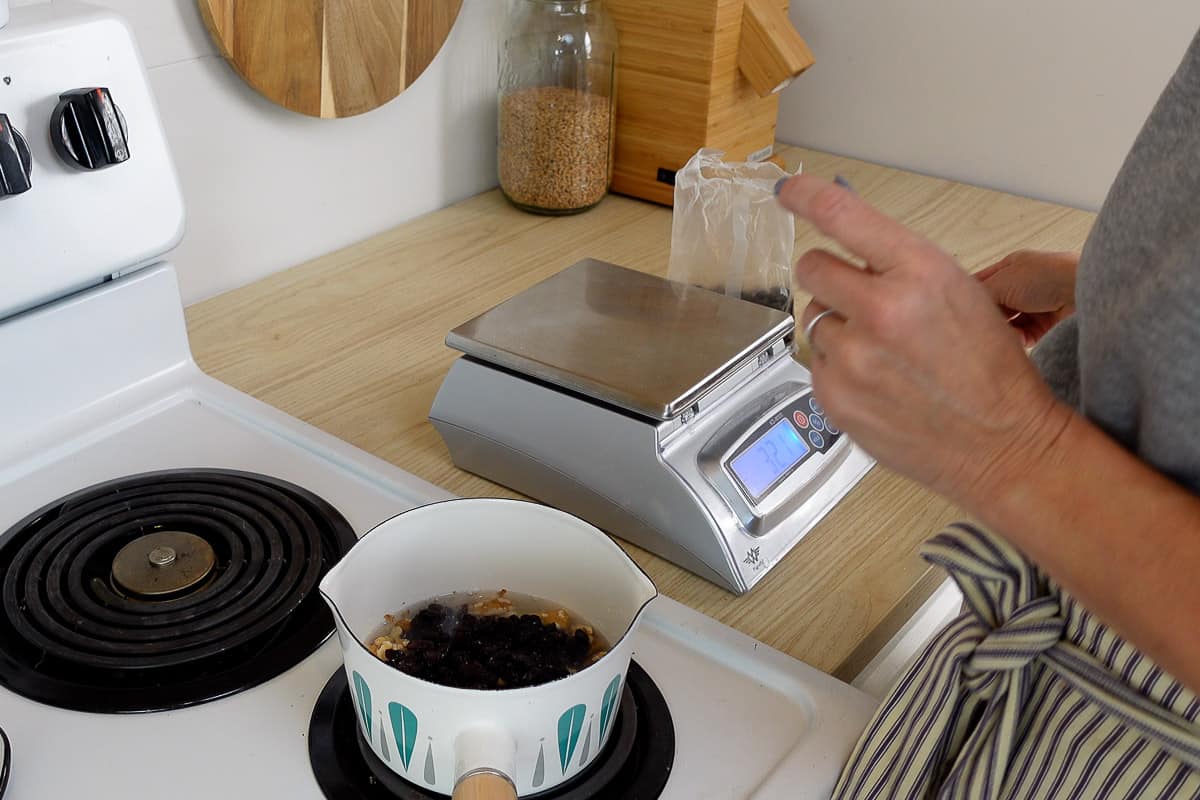
Step 4: Stretch and fold
Perform one set of stretches and folds to the dough. To perform a set, while the dough is still in the bowl, pick up one side with a wet hand.
Pull it up and over itself. Turn the bowl and repeat this action on 4 sides of the dough until the bowl has come full circle.
Cover the bowl and let the dough rest for 30 minutes.
Step 5: Add walnuts and raisins to the dough
Drain the water from the raisins and walnuts and then add them to the bowl of dough.

Use your hands to mix them into the dough until they are evenly incorporated.
Cover the bowl and let it rise 30-50% at room temperature, for 3-5 hours depending on the temperature of your kitchen. This is the bulk fermentation stage.
Step 6: Prepare the butter spread
Right before the dough is ready to shape, mix 4 tablespoons of softened butter with ¼ cup of brown sugar, 2 teaspoons cinnamon, ½ teaspoon vanilla extract, and a pinch of nutmeg. Set aside.
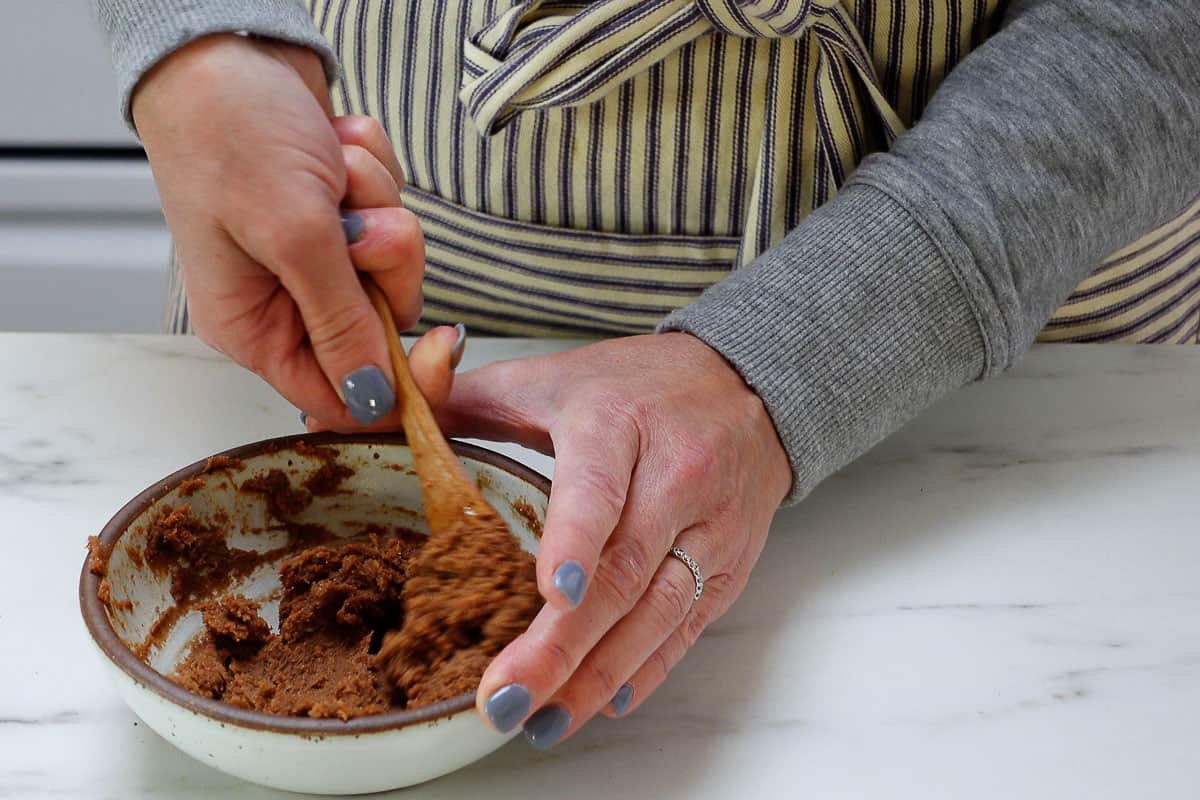
Step 7: Spread the butter mixture on the dough
Turn the dough out onto a floured work surface. Use your hands to gently press the dough out into a 12 x 10"rectangle. Flour your hands to prevent the dough from sticking. (There's no need to use a rolling pin.)
Spread the butter mixture over the dough being careful to keep it 1-1 ½ inches from the edges.

Step 8: Fold the dough
Pick the right side of the dough up and fold it towards the center and repeat with the left side. (photos 1-2)
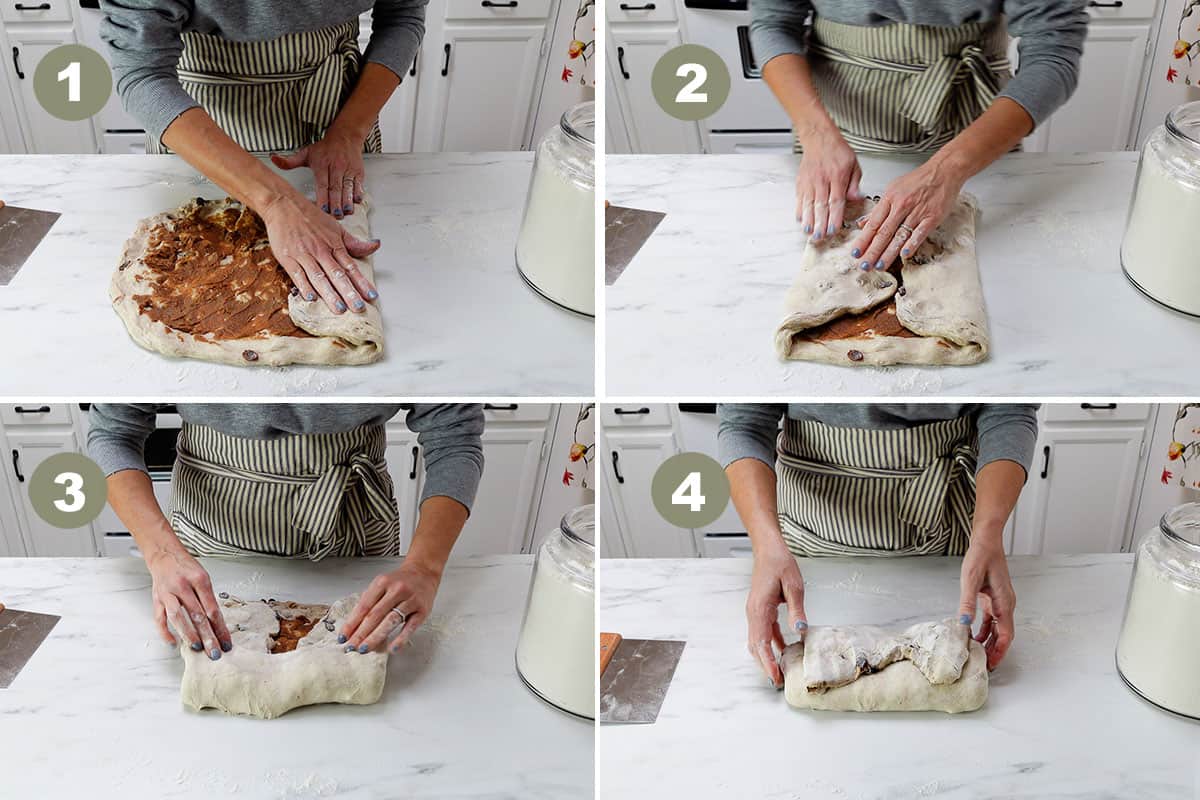
Pick the top side up and fold it towards the center and repeat with the bottom side. (photos 3-4)
Fold the dough in half and then flip it over so that the seam-side is facing down. (photos 5-6)
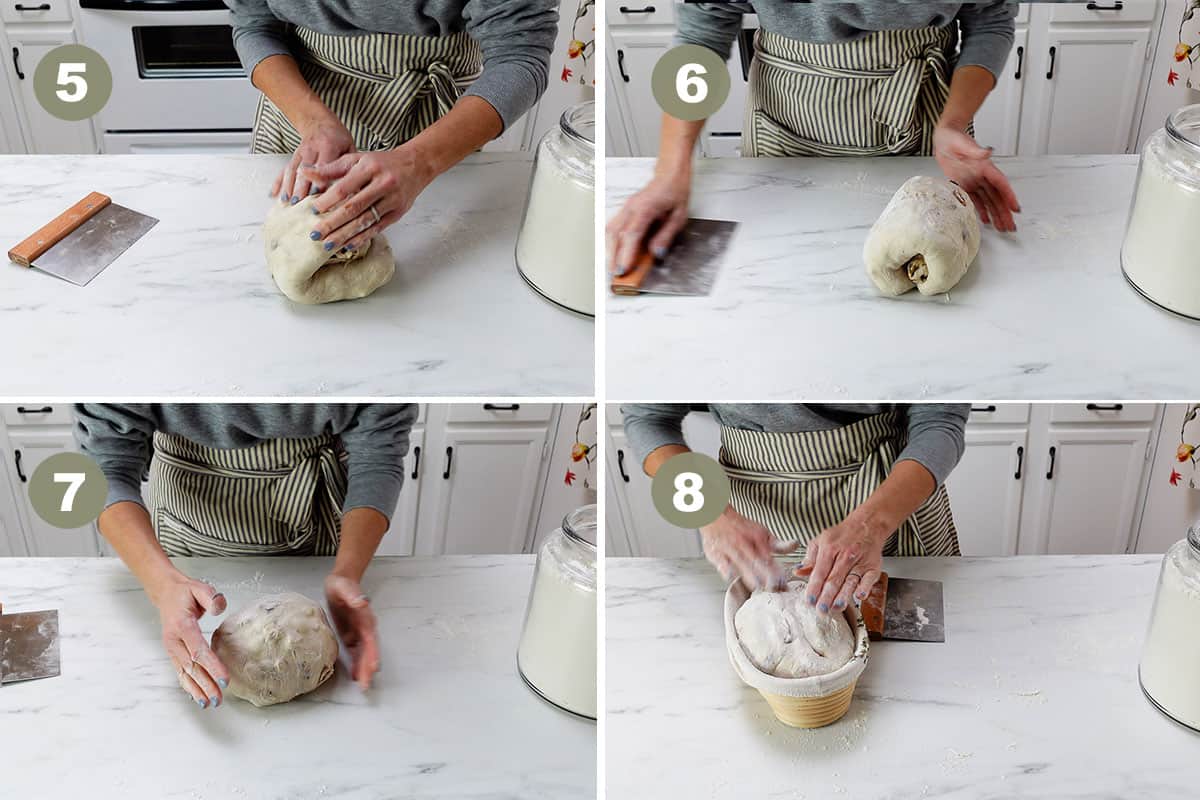
Pull the dough towards you while turning it to create a taut skin on the outside. Dust flour on the outside of the dough and flip it into a lined banneton that has been floured. (photos 7-8)
Cover the banneton with plastic wrap or a damp tea towel.
Step 9: Rise
If you'd like to bake the same day, allow the dough to continue to rise at room temperature until it has reached the top of the banneton.
For a long ferment, let the dough sit on the counter for 30 minutes before placing it in the fridge overnight.
Step 10: Bake
Preheat your oven to 450°F (232°C) with a dutch oven inside. Once the oven is hot remove the dutch oven and set it on top of the stove.
Turn the dough out onto a piece of parchment paper. Use a razor to make 3 very shallow slits across the top of the dough.

Using the parchment paper as a sling, lift the dough up and into the dutch oven. Bake covered for 30 minutes and uncovered for 20 minutes.
Step 10: Cool
Place a cooling rack onto a piece of parchment paper or baking sheet. (This will catch any melted butter that may drip from the baked loaf.)
Transfer the loaf to the wire rack and allow it to cool completely.
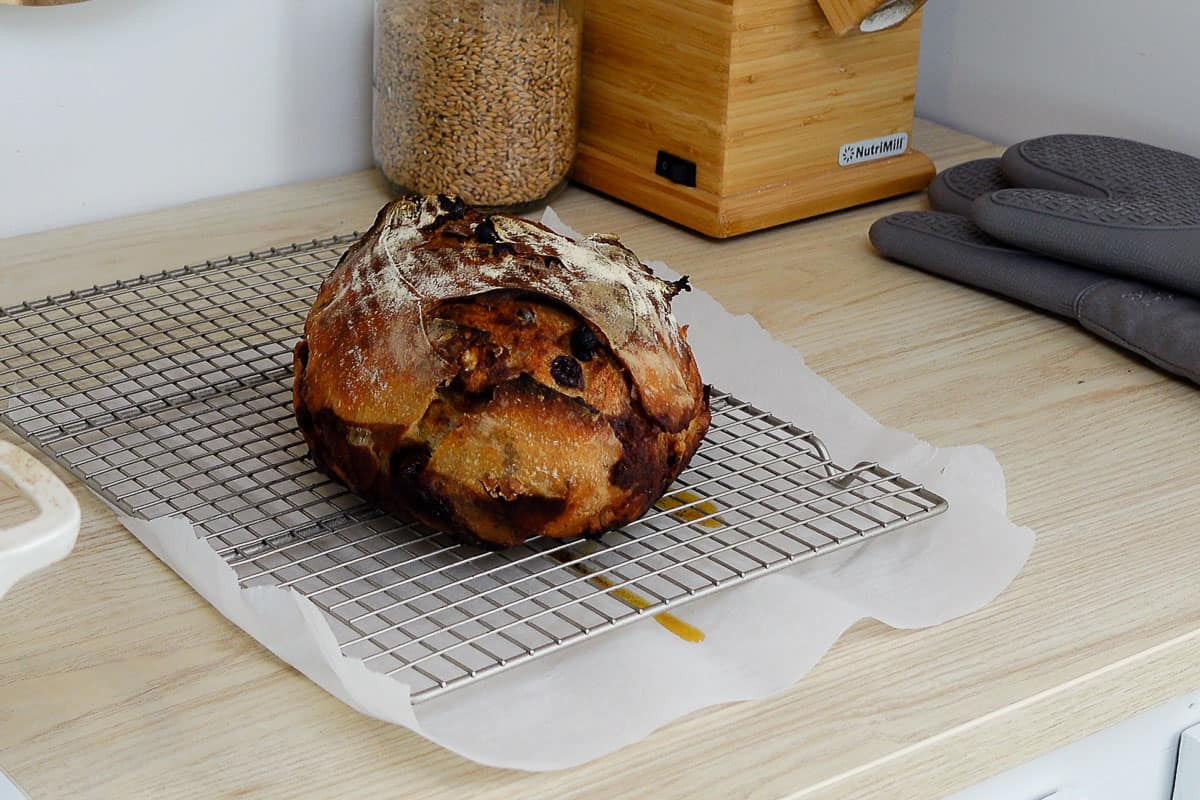
Tips for making cinnamon raisin sourdough bread
As tempting as it might be, don't cut into the bread before it cools. (Trust me, I know it will be hard. Your kitchen is going to smell divine!)
Because there is essentially melted butter on the inside, if you cut it while it's still hot, you'll end up with a gummy mess!
The butter and sugar in the dough will also create a darker crust on the bottom of the bread. I've not found a way to get around this. (Please share tips in the comment section if you have any!)
This cinnamon raisin sourdough bread recipe can be baked in a loaf pan lined with parchment paper. Place it into the loaf pan seam-side down after you have shaped it. Bake at 400°F (204°C) for 35-40 minutes.
How to store and freeze
Store the bread in a plastic bag or bread bag at room temperature for up to 2 days.
I love to store slices of sourdough bread in the freezer. Place small sheets of parchment paper between each slice so that they do not freeze together. Store in a freezer-safe bag in the freezer for up to a month.
When you are ready to eat, simply take whatever portion you need out of the freezer and allow it to thaw to room temperature.
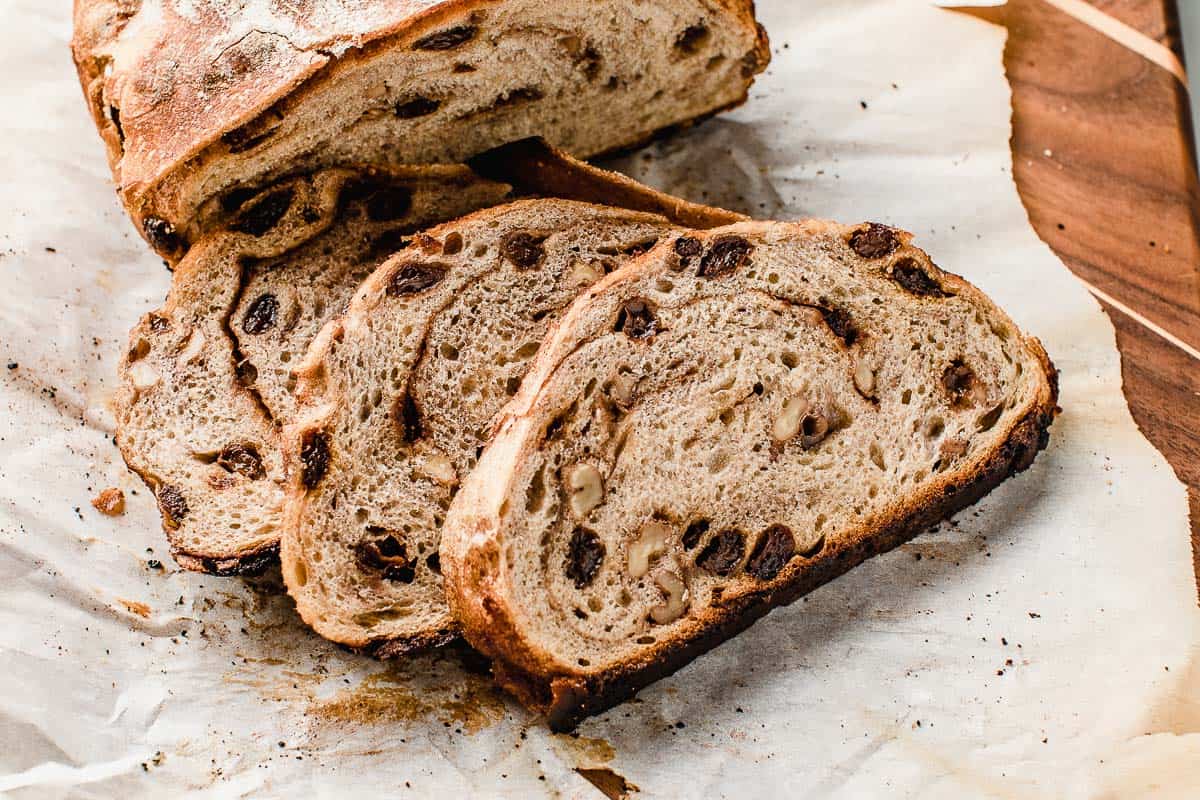
More easy sourdough recipes to try: beginners sourdough bread / sourdough cinnamon rolls / jalapeno cheddar sourdough bread / olive and walnut sourdough bread
Do you like this recipe? Make sure to subscribe to our newsletter and we'll send you fresh recipes, valuable troubleshooting advice, useful tips, and other information we believe will be helpful to you!

Cinnamon Raisin Sourdough Bread
INGREDIENTS
Ingredients to make ½ cup (100 g) of active sourdough starter
- 1 tablespoon (15 g) sourdough starter
- ⅓ cup + 1 tablespoon (50 g) all-purpose flour
- 3 ½ tablespoons (50 g) water
Dough Ingredients
- ½ cup (100 g) active sourdough starter
- 1 ½ cups + 1 tablespoon (375 g) water
- 2 teaspoons (10 g) salt
- 3 ⅓ cups (400 g) bread flour
- ⅓ cup + 1 tablespoon (50 g) whole wheat flour
- ⅓ cup + 1 tablespoon (50 g) rye flour
Add-ins
- ½ cup raisins
- ½ cup walnuts
Cinnamon Sugar Filling
- 4 tablespoons butter (room temperature)
- ¼ cup brown sugar
- 2 teaspoons cinnamon
- ½ teaspoon vanilla extract
- pinch of nutmeg
INSTRUCTIONS
Feed your starter
- 12 hours before you plan to mix the dough, add the ingredients to make ½ cup (100 g) of active sourdough starter to a clean jar. Stir until combined, loosely cover the jar and let the starter rise at room temperature. (The ingredients will create a total of 115 g active starter but, because some of it will stick to the sides of the jar during the transfer, we are making a little more than needed.) The sourdough starter is ready to use when it has doubled in size and there are plenty of bubbles on the surface and sides of the jar.
Make the Dough
- Mix the dough: In a large mixing bowl stir together 100 grams of active sourdough starter, 375 grams of water, and 10 grams of salt. (This step will ensure the starter is evenly distributed throughout the dough.) Next add 50 grams of whole wheat flour, 50 grams of rye flour, and 400 grams of bread flour to the bowl. Use your hands to combine the ingredients until there are no dry bits and the dough looks like a shaggy mass. Cover the bowl and let the dough rest on the counter for 1 hour.
- Prepare walnuts and raisins: While the dough is resting, prepare the raisins and walnuts. Bring a small pot of water to a simmer and turn the burner off. Add ½ cup of walnuts and ½ cup of raisins to the pot, making sure they are covered by the hot water. Allow them to sit in the hot water until it's time to mix them into the dough.
- Stretch and fold: Perform one set of stretches and folds to the dough. To perform a set, while the dough is still in the bowl, pick up one side with a wet hand. Pull it up and over itself. Turn the bowl and repeat this action on 4 sides of the dough until the bowl has come full circle. Cover the bowl and let the dough rest for 30 minutes.
- Add walnuts and raisins to the dough: Drain the water from the raisins and walnuts and then add them to the bowl of dough. Use your hands to mix them into the dough until they are evenly incorporated. Cover the bowl and let it rise 30-50% at room temperature, 3-5 hours depending on the temperature of your kitchen.
- Prepare butter spread: Right before the dough is ready to shape, mix 4 tablespoons of softened butter with ¼ cup of brown sugar, 2 teaspoons cinnamon, ½ teaspoon vanilla extract, and a pinch of nutmeg. Set aside.
- Spread butter mixture on the dough: Turn the dough out onto a floured work surface. Use your hands to press the dough out into a 12 x 10"rectangle. Flour your hands to prevent the dough from sticking. Spread the butter mixture over the dough being careful to keep it 1-1 ½ inches from the edges.
- Shape the dough: Pick the right side of the dough up and fold it towards the center and repeat with the left side. Pick the top side up and fold it towards the center and repeat with the bottom side. Fold the dough in half and then flip it over so that the seam-side is facing down. Pull the dough towards you while turning it to create a taut skin on the outside. Dust flour on the outside of the dough and flip it into a lined banneton that has been floured. Cover the banneton with plastic wrap. (I use a reusable shower cap.)
- Second rise: If you'd like to bake the same day, allow the dough to continue to rise at room temperature until it has reached the top of the banneton. For a long ferment, let the dough sit on the counter for 30 minutes before placing it in the fridge overnight.
- Bake: Preheat your oven to 450°F (232°C) with a dutch oven inside. Once the oven is hot remove the dutch oven and set it on top of the stove. Turn the dough out onto a piece of parchment paper. Use a razor to make 3 very shallow slits across the top of the dough. Using the parchment paper as a sling, lift the dough up and into the dutch oven. Bake covered for 30 minutes and uncovered for 20 minutes.
- Cool: Place a cooling rack onto a piece of parchment paper or baking sheet. (This will catch any melted butter that may drip from the baked loaf.) Transfer the loaf to the cooling rack and allow it to cool completely.





Michelle Callaway says
I have made the single loaf recipe 3 time now and we love it.
Michelle Callaway says
can I double the recipe so I can make two loaves?
Amy says
Yes you can.
Nancy Wein says
My dough is not rising in the final proof. Help!
Amy says
How long has it been rising and what temperature is your kitchen?
Angie says
Can you substitute raisins with something else?
Also, can you just use Einkorn flour only?
Amy says
Yes you can use any dried fruit. If you want to make it with Einkorn flour I would use my einkorn sourdough recipe for the dough.
Lisa says
Just making this recipe now. wondering if einkorn and kamut are interchangeable in recipes?
Amy says
They are similar yes.